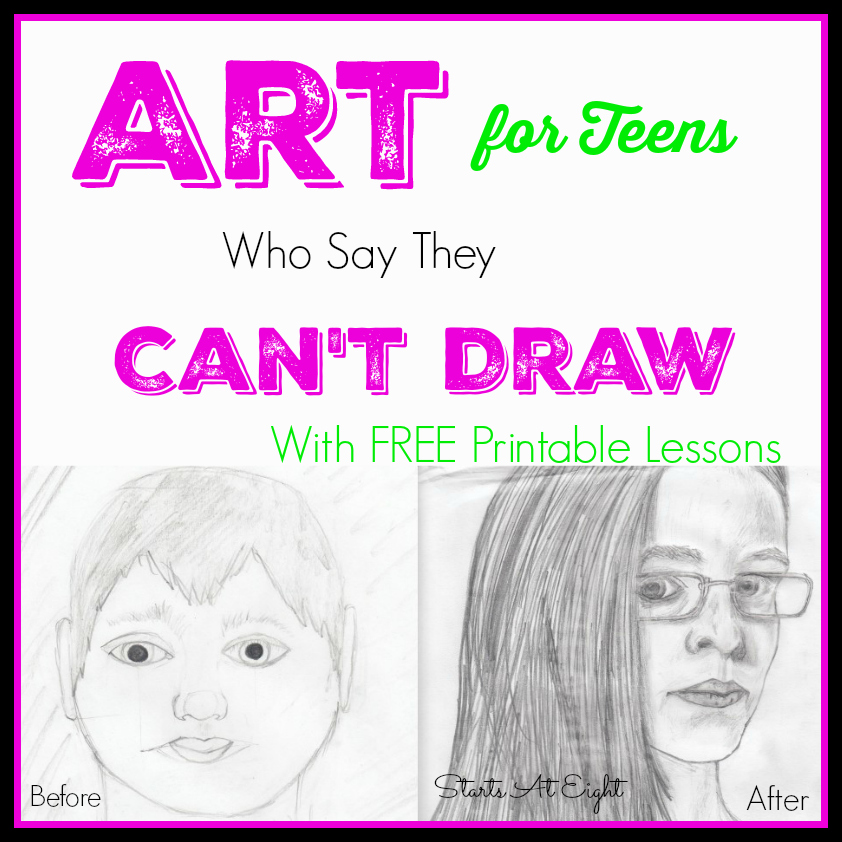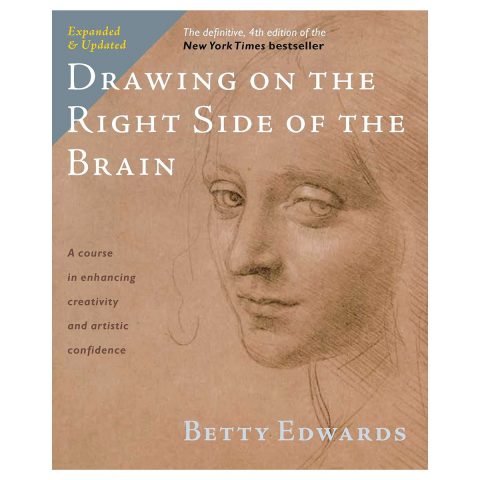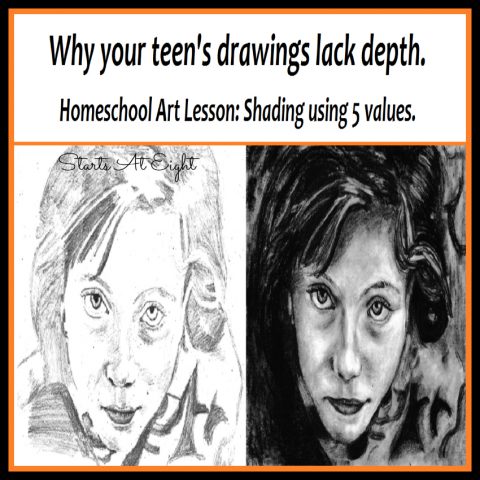Art for Teens Who Say They Can’t Draw

Does your teenager say things like,
“I can’t draw! I’m no good at art! I draw like a kid!”
Are you discouraged to see your teen, who used to love drawing, give up in frustration? Maybe you look at his drawings and say,
“Well, they don’t look so horrible. They’re better than they used to be.”
But, are they realistic? That’s your teen’s standard. It’s not enough to be better than when he was ten. It needs to look real!
Art for Teens
Your daughter may continually focus on a subject she feels confident drawing. For me it was trees. Some teens will draw horses, manga, trucks, and so on. Whatever she feels confident drawing realistically.
So is your teen bad at drawing? His drawings are not realistic, so in that sense yes, he is. He may draw eyes on the forehead, stumpy trees or floating cups. Yes, he’s bad at drawing, but so was I.
What is it that makes him bad at drawing? Is it a lack of manual dexterity? Clearly not, since he was able to learn to write. What about his eyes, don’t they work? It’s not that either since he learned to read. So it must clearly be his brain… that artistic part of the brain must be missing! Quick order a brain scan! Seriously, it is the brain, but there’s hope for him yet!
Right Brain vs. Left Brain
Your teenager needs to shift from one way of thinking to another more artistic way to draw realistically. Left brain and right brain are terms you likely heard before. Our brains can think in two ways as discovered by Roger W. Sperry, a psychobiologist in 1968. One way is verbal, analytical and sequential, the other way is visual, perceptual and simultaneous.
Modern neuroscience has since shown it to be much more complicated than Roger Sperry knew to separate the roles of the two hemispheres. So to avoid outdated terminology of right brain/left brain let’s just say our everyday brain vs our artistic brain.
With our everyday brain we are not actually seeing things as they are, instead we are labeling and categorizing what we see to process what is important. So when we see with our everyday brain the intricacies of the world fade out for a broader more comprehensive view.
Our artistic brain is capable of looking at the details, of really seeing and taking it all in. Look at your hand really closely for a minute. Observe all the little ridges and shapes. Trace your eyes along the edges of your fingers noticing the little details, the wrinkles, the shapes the light makes on your nails. When you see all those details and painstakingly transfer them to paper you become an artist!
Often people will stumble upon this in an aha moment. My friend described her own aha experience this way:
“I was told not to draw what I thought I saw, but what I really saw. So I sat down and really looked at a chair. When I finished drawing it, I looked at my drawing and was surprised by how good it was. I said, “That’s the chair!””
So if it’s that simple why aren’t more people artistic? It’s because we’re so comfortable seeing with our everyday brain that the shift can be incredibly difficult! Difficult, but fixable.
Right now your teen is drawing with their everyday brain, categorizing and naming parts then drawing symbols to represent those parts. Symbols will never look realistic. To draw realistically they need to learn to use their artistic brain. They need to see the details and draw the true world.
Art for Teens Drawing Exercises
Here are five drawing exercises for you to download that will help students to see accurately. They are effective because they force the student to look carefully at outlines and shapes instead of drawing what they think they see.
1. Gesture Drawing
Looking for the essence of a figure beginning with one defining line.
2. Blind Contour Drawing
Tracing outlines with the eye as your pencil travels at the same rate.
3. Drawing Negative Spaces
Improve accuracy by seeing the shapes in the negative spaces.
4. Continuous Line Drawing
Think carefully about the contour lines and mark slowly.
5. Copy A Master
Carefully reproduce drawings of a master artist.
Additional Drawing Practice
In addition to the 5 exercises above, be sure to check out this book and corresponding workbook:
In 1979, Betty Edwards released her book, “Drawing on the Right Side of the Brain.” Betty Edwards is an art teacher who was fascinated by Roger Sperry’s research. In her book, she reveals in detail the barriers to seeing like an artist and provides clear and simple exercises that help you shift to an artistic way of thinking.
Your teen can begin to draw realistically within days using these exercises! Adults who have not drawn in years and still draw like children are taught to draw realistic portraits from life after a day and a half seminar! You can go ahead and get her book, it’s excellent! For now, have your teen try out her first exercise at her website for free.
Is this a fix all for your teen?
Learns to see the world and voila she’s a Michelangelo? Sadly, no. I had my aha moment years ago, way before I’d ever heard of Betty Edwards or blind contour drawings, and yet my art still has a long way to go.
It’s a step in the right direction. Learning to draw realistically gives teens the confidence to continue their artistic journeys. Help your teen to put away childish symbol drawings and they will embrace discovering their full potential!
What comes next?
Once your teen can see the world accurately and draw realistically they can really begin their artistic journey. They will learn different mediums, techniques, and develop a unique style. Learn to draw imaginatively with inspiration. Form compositions that have balance, harmony and contrast.
What can we do to help them on this journey?
As young artists start out they need one thing more than anything else: encouragement. They need the encouragement of their parents and peers to push and challenge themselves. Art that is quickly done can be lovely, but art labored over with focused attention will inspire awe. Without encouragement, most artists will stagnate doing only what is easy.
So be sure to use these FREE Art for Teens activities to help push and inspire your teen artist.





March 26, 2016 @ 9:04 pm
Love this post Crystal, I am going to check this book out for my daughter 🙂 Thank you for sharing!
Art! Drawing part 1 | farmschooliowa
March 28, 2016 @ 12:05 pm
[…] just read an AMAZING blog post on how to teach art to your teens. Drawing specifically. She explains right/left brain and some […]
March 29, 2016 @ 5:11 pm
We once had an art teacher tell my 11 year old (who refused to take her class because he couldn’t draw) to use tracing paper and graphite if it made him feel better. She told him to think of them as drawing tools and not to worry; the more he would copy the more practice he was getting drawing and that’s all that mattered. I was so stunned! I would have thought tracing was considered “cheating!” but it did help him continue art and for that I’m grateful.
ART! Drawing part 2 – farmschooliowa
April 20, 2016 @ 12:28 pm
[…] Inspire My Artist guest post on drawing for Starts at Eight […]
August 29, 2017 @ 6:46 pm
As a homeschooling mom I taught all five of my children to draw using “Drawing on the Right Side of the Brain” as well as many other homeschoolers (and their parents). Now, as owner of an art center in a small town, I use the same concepts to teach students of all ages to draw. It never gets old (although I now own the most recent version of the book.) And, yes – at times we use tracing paper for certain projects, such as pastels. Sometimes it is more important to get the image onto the paper so that you can just move on and use the medium, than it is to struggle with the drawing aspect – students get stuck trying to make the drawing perfect.
August 29, 2017 @ 10:47 pm
Thank you so much for your insight Sandra! I know I have often felt guilty when thinking about letting the kids trace something just to get them going on a project. It is good to know that someone else advocates for this in certain circumstances!
Art for Teens Who Say They Can’t Draw – Homeschool Freebie of the Day
September 20, 2018 @ 1:01 am
[…] CLICK HERE to go to the website! […]
September 16, 2020 @ 11:48 am
This website is no longer accessible with your link.
September 16, 2020 @ 11:51 am
Actually it’s some of the links at the website that don’t work
September 23, 2020 @ 9:37 am
Thank you for letting me know! I have updated all the links!